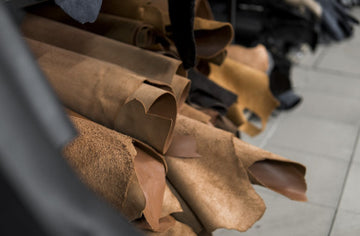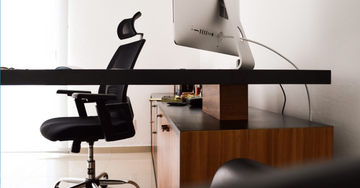Top vs Split vs Bonded Leather: Your Ultimate Guide to Leather Grades
by Khent Barangas on Sep 15, 2025

Leather has always been one of the most coveted materials in fashion, furniture, and design. Yet for all its appeal, it is also surrounded by misconceptions, especially when it comes to leather grades and how they truly define quality.
Not all leather is created equal. In fact, that shiny “genuine leather” label you often see may not be as genuine as it sounds. Believe it or not, it usually ranks lower in quality than other cuts of leather.
In this guide, we will explain leather grades simply and clearly, so you can spot the difference, avoid the marketing tricks, and pick the type of leather that is truly worth having.
What Exactly Are Leather Grades?

When people hear the term leather grades, they often imagine a simple “good, better, best” scale. In reality, grading is just a way the industry classifies leather based on cut, grain, and processing.
At its core, leather grades describe how the leather was cut from the hide, how much of the natural grain remains, and what finishing processes were applied.
Microscopic and materials science research confirms that leather isn’t uniform throughout. The upper layers have a higher density of tightly packed collagen fibers. These fibers are what give leather its toughness, resistance to wear, and ability to age beautifully.

So, what does this mean in leather grading?
The grading system is essentially built on this science: the closer the leather is to that dense, natural top layer, the higher the grade and the longer it will last. The deeper you go into the hide, the weaker the leather becomes. It might look smooth and polished on the outside, but it will not be as strong or long-lasting as the top layers.
It is important to note, however, that there is no single official standard for grading leather worldwide.
3 Main Types of Leather Grades
Even though there is no single global standard, most of the industry recognizes three main categories when it comes to leather grades. These give us a clear way to compare how leather is cut and finished.
1. Top-Grain Leather

Top-grain leather comes from the upper layer of the hide, where the grain is found. This part holds the densest and strongest fibers, making it naturally tough, flexible, and more resistant to wear than split or bonded leather.
Its grain layer also gives top-grain leather a smoother, more polished appearance. This refined look is why it is often used in premium products such as bags, shoes, and furniture.
There are generally two subtypes of Top-Grain Leather:
Full-Grain Leather
Full-grain leather is widely regarded as the highest-quality leather grade. It uses the entire grain layer of the hide, preserving the natural tight fiber structure that gives it remarkable strength, flexibility, and longevity. Because it retains all the natural surface, including scars, pores, and markings, each piece is unique and develops character over time.
One of the standout features of full-grain leather is its ability to develop a rich patina with use. This natural aging process enhances the color and texture, making the leather more attractive the longer it is used.
Corrected Grain Leather
This leather has its surface sanded or buffed to remove natural imperfections such as scars or wrinkles. It is then dyed or embossed to achieve a smooth, uniform look.
This process makes corrected-grain leather easier to clean and maintain, while retaining much of the strength and durability of top-grain. Though it is less breathable than full-grain, it is more resistant to stains and scratches, which makes it a popular choice for furniture like office chairs as well as fashion items.
2. Split Leather

Split leather comes from the corium, the inner layer of the hide that remains after the top-grain has been removed. Its fiber structure is looser, which makes it softer and more flexible, but also less durable than top-grain leather.
To make it usable, split leather often undergoes heavy processing such as coating, embossing, or finishing treatments. Even though it does not have the same strength or longevity as higher grades, it is still widely used in products like work gloves, chairs, footwear linings, and more affordable furniture.
Split leather can be processed in different ways to create distinct finishes:
Suede
This leather is soft and fuzzy to the touch because the inner surface of the leather is sanded. It is flexible and stylish, but it absorbs water and stains easily, so it needs extra care.
Bicast Leather
The Bicast leather is often marketed as “genuine leather,”. However, this can be misleading since it does not have the same strength or breathability as top-grain. It is created by coating split leather with polyurethane or vinyl, then embossing it to mimic the look of natural grain.
Patent Leather
This leather is produced by applying a high-gloss coating over the leather, resulting in a shiny, mirror-like finish. Modern patent leather is often made from split or bicast as the base, then layered with plastics for that signature shine. While it makes a bold style statement, it is less about durability and more about fashion appeal.
3. Bonded Leather

Bonded leather is often seen as the “recycled” version of leather. Instead of being cut directly from a hide, it is made from leftover scraps and fibers. These are shredded, mixed with a bonding agent like polyurethane or latex, and then pressed onto a fabric backing.
Because bonded leather has no real grain structure, it is much less durable. It can crack, peel, or fade quickly, and the actual leather content inside varies a lot depending on the manufacturer. This is why bonded leather is often considered the lowest-quality option.
The Truth About Genuine Leather
“Genuine leather” is one of the most misunderstood labels in the leather world. It does not actually describe a specific leather grade.
While the term sounds like it should mean high quality, it usually refers to leather that has been heavily processed. In many cases, it comes from lower layers of the hide or from bicast leather, which is made by coating split leather with a synthetic finish.
The term is more about marketing than quality. Products labeled as genuine leather are technically real leather, but they usually lack the durability, strength, and natural beauty found in higher grades like full-grain or top-grain.
Because of its affordability and wide availability, genuine leather is commonly found in belts, wallets, and budget furniture. It may look like leather on the outside, but it does not age as well or last as long.
Make Smart Leather Purchasing Decisions
Remember that leather quality levels directly correlate with longevity and performance. While lower grades serve budget-conscious consumers, investing in higher-quality leather often provides better value through extended lifespan and superior aging characteristics.
The next time you encounter different types of leather, you'll have the knowledge to assess quality, negotiate fair prices, and choose the right grade for your specific needs.
Frequently Asked Questions About Leather Grades
Is genuine leather a good quality?
Despite its name, genuine leather is actually a lower quality grade made from hide layers remaining after premium grains are removed. It's less durable than full-grain or top-grain leather but more affordable.
What is the difference between top-grain and full-grain leather?
Top-grain leather, the main type of leather grade, comes from the upper layer of the hide and can be either full-grain or corrected-grain. Full-grain retains the entire natural surface, making it the strongest and most durable option, while corrected-grain is lightly sanded or buffed to remove imperfections, giving it a smoother, more uniform look.
Both types maintain much of the strength and durability of the hide, which is why top-grain is widely used in bags, shoes, and furniture, even if corrected-grain sacrifices some of the natural character for appearance.
How can I tell if something is made from bonded leather?
Bonded leather often looks uniform and smooth, with a synthetic feel. Checking the edges or the back of the material usually reveals a layered or plastic-like appearance. It also tends to have a chemical smell instead of the natural scent of leather.









